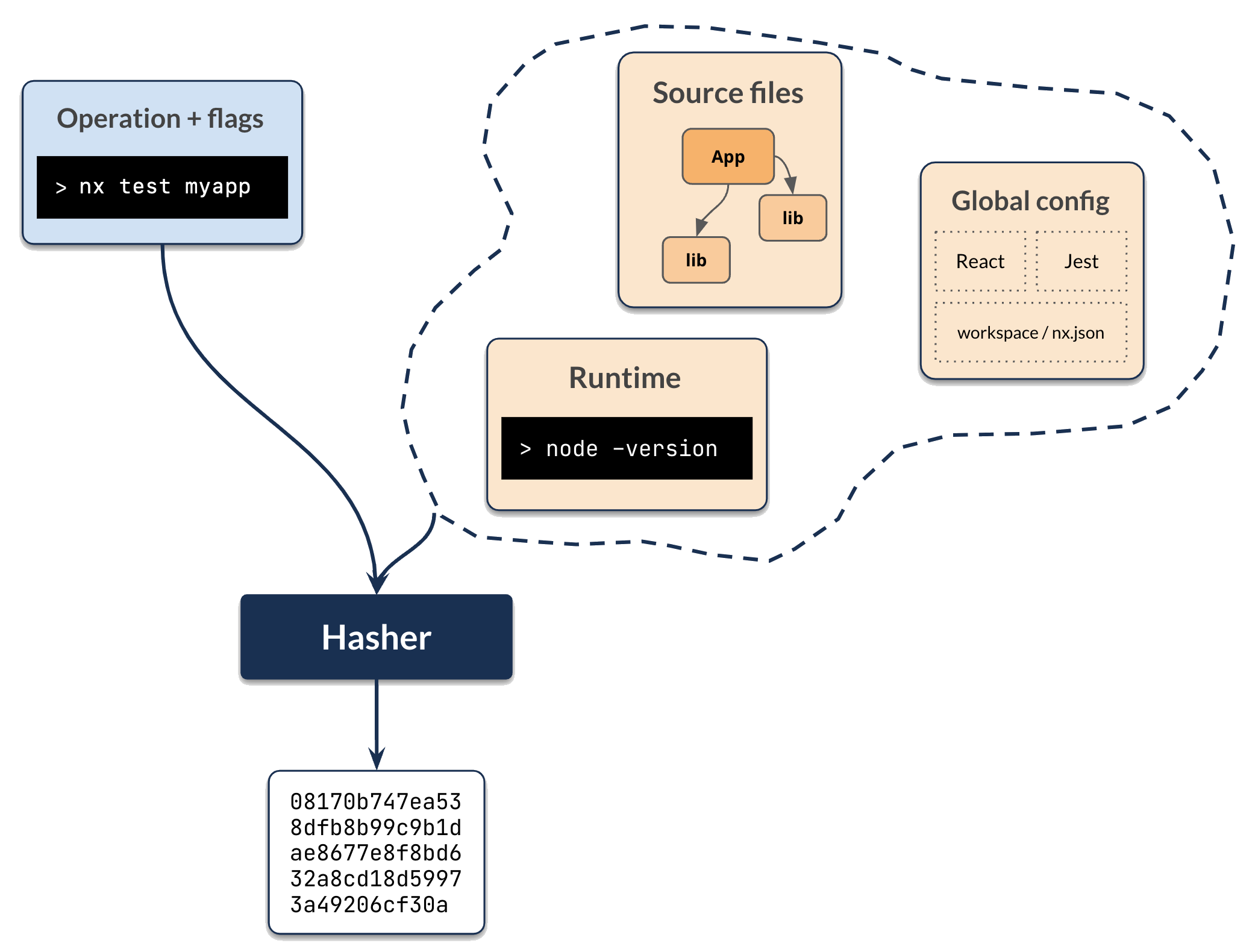How Caching Works
Before running any task, Nx computes its computation hash. As long as the computation hash is the same, the output of running the task is the same.
By default, the computation hash for - say - nx test remixapp includes:
- All the source files of
remixappand its dependencies - Relevant global configuration
- Versions of external dependencies
- Runtime values provisioned by the user such as the version of Node
- CLI Command flags

This behavior is customizable. For instance, lint checks may only depend on the source code of the project and global configs. Builds can depend on the dts files of the compiled libs instead of their source.
After Nx computes the hash for a task, it then checks if it ran this exact computation before. First, it checks locally, and then if it is missing, and if a remote cache is configured, it checks remotely.
If Nx finds the computation, Nx retrieves it and replays it. Nx places the right files in the right folders and prints the terminal output. From the user’s point of view, the command ran the same, just a lot faster.
If Nx doesn’t find a corresponding computation hash, Nx runs the task, and after it completes, it takes the outputs and the terminal logs and stores them locally (and if configured remotely as well). All of this happens transparently, so you don’t have to worry about it.
Although conceptually this is fairly straightforward, Nx optimizes this to make this experience good for you. For instance, Nx:
- Captures stdout and stderr to make sure the replayed output looks the same, including on Windows.
- Minimizes the IO by remembering what files are replayed where.
- Only shows relevant output when processing a large task graph.
- Provides affordances for troubleshooting cache misses. And many other optimizations.
As your workspace grows, the task graph looks more like this:
All of these optimizations are crucial for making Nx usable for any non-trivial workspace. Only the minimum amount of work happens. The rest is either left as is or restored from the cache.
Source Code Hash Inputs
The result of building/testing an application or a library depends on the source code of that project and all the source codes of all the libraries it depends on (directly or indirectly).
By default, Nx is conservative. When running, say, nx run test --script=remixapp Nx will consider all the files in the remixapp directory and all the files in the header and footer directories (remixapp dependencies). This would result in unnecessary cache misses. For instance, we know that changing a footer's spec file will not change the result of the test command above.
We can define a more precise configuration as follows:
{
"namedInputs": {
"default": ["{projectRoot}/**/*"],
"production": ["!{projectRoot}/**/*.spec.tsx"]
},
"targetDefaults": {
"build": {
"inputs": ["production", "^production"]
},
"test": {
"inputs": ["default", "^production", "{workspaceRoot}/jest.config.ts"]
}
}
}
{projectRoot} is a key word that is replaced by the path to the current project's root directory.
With this configuration, the build script will only consider the non-test files of remixapp, header and footer. The test script will consider all the source files for the project under test and only non-test files of its dependencies. The test script will also consider the jest config file at the root of the workspace.
For more information about modifying inputs and namedInputs for your own repo, read Customizing Inputs
Runtime Hash Inputs
Your targets can also depend on runtime values.
{
"targetDefaults": {
"build": {
"inputs": [{ "env": "MY_ENV_NAME" }, { "runtime": "node -v" }]
}
}
}
Args Hash Inputs
Finally, in addition to Source Code Hash Inputs and Runtime Hash Inputs, Nx needs to consider the arguments: For example, nx build remixapp and nx build remixapp -- --flag=true produce different results.
Note, only the flags passed to the npm scripts itself affect results of the computation. For instance, the following commands are identical from the caching perspective.
npx nx build remixapp
npx nx run-many --target=build --projects=remixapp
In other words, Nx does not cache what the developer types into the terminal.
If you build/test/lint… multiple projects, each individual build has its own hash value and will either be retrieved from cache or run. This means that from the caching point of view, the following command:
npx nx run-many --target=build --projects=header,footer
is identical to the following two commands:
npx nx build header
npx nx build footer
What is Cached
Nx works on the process level. Regardless of the tools used to build/test/lint/etc.. your project, the results are cached.
Nx sets up hooks to collect stdout/stderr before running the command. All the output is cached and then replayed during a cache hit.
Nx also caches the files generated by a command. The list of files/folders is listed in the outputs property of the project's package.json:
{
"nx": {
"targets": {
"build": {
"outputs": ["{projectRoot}/build", "{projectRoot}/public/build"]
}
}
}
}
If the outputs property for a given target isn't defined in the project' s package.json file, Nx will look at the targetDefaults section of nx.json:
{
...
"targetDefaults": {
"build": {
"dependsOn": [
"^build"
],
"outputs": [
"{projectRoot}/dist",
"{projectRoot}/build",
"{projectRoot}/public/build"
]
}
}
}
If neither is defined, Nx defaults to caching dist and build at the root of the repository.
Skipping Cache
Sometimes you want to skip the cache. If, for example, you are measuring the performance of a command, you can use the --skip-nx-cache flag to skip checking the computation cache.
npx nx run build --skip-nx-cache
npx nx run test --skip-nx-cache
Customizing the Cache Location
The cache is stored in node_modules/.cache/nx by default. To change the cache location, update the cacheDirectory option for the task runner in nx.json:
{
"tasksRunnerOptions": {
"default": {
"options": {
"cacheableOperations": ["build", "test"],
"cacheDirectory": "/tmp/mycache"
}
}
}
}

